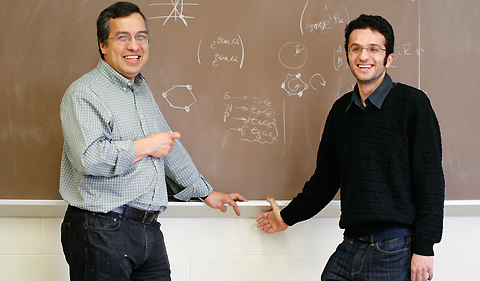By Jean Andrews
Physics & Astronomy
Analyzing the motion of electrons, Ohio University researchers have developed a process to discriminate among different impurities in graphene–the strong, light and conductive material only one atom thick being studied for a variety of nanoscale applications.
Physics doctoral student Mahmoud Asmar and Dr. Sergio Ulloa published a paper, “Spin-orbit interaction and isotropic electronic transport in graphene” this week in Physical Review Letters, the journal of the American Physical Society.
The two researchers focused on the role of a relativistic effect on the electronic properties of graphene–and in how this effect could be measured and observed in the lab.
Graphene, a crystalline one-atom thick layer of graphite (a form of carbon), is perhaps one of the most important materials being studied worldwide. The European Commission, for example, has invested 1 billion euros ($1.5 billion) in its ”Graphene Flagship,“ an academic-industrial consortium with an aim to make technological breakthroughs using this material.
“Graphene studies promise a host of different applications,” explains Ulloa, Professor of Physics and Astronomy. “It’s extremely important that we understand all its properties, especially how robust it is to defects that would limit the electron mobility and, therefore, many of its desirable properties. I’m very pleased with Mahmoud’s contribution to this undertaking in a globally competitive area.”
“We provide a procedure that can lead to the experimental detection method for impurities and defects that lead to the generation of spin orbit interactions by the analysis of the electrons motion in this material,” Asmar said.
“Since no material is 100% perfect due to the presence of defects and attached impurities, we show that the defects or impurities that lead to the generation of spin-orbit interactions lead to a drastic change in the ‘relativistic –like’ transport of electrons in graphene.”
“Mahmoud has theoretically advanced the field significantly,” Ulloa said. “He has demonstrated that a typically weak ’spin-orbit effect‘ in graphene would have dramatic consequences on its electrons, limiting their ability to overcome obstacles introduced by natural vacancies and imperfections in the material. His work shows how to uniquely characterize this effect in experiments and obtain a quantitative measure of its strength in different samples.”
This research was supported by the National Science Foundation and is part of general collaborative efforts with Dr. Nancy Sandler, Associate Professor of Physics & Astronomy, as well as with colleagues at the University of Florida, Oakland University in Michigan, and researchers in Argentina, Brazil and Chile. This work also was partially carried out while Ulloa and Asmar were in Berlin, Germany, during the 2013 academic year and was made possible through support from Ohio University’s College of Arts & Sciences, the Department of Physics & Astronomy, the Nanoscale & Quantum Phenomena Institute (NQPI), the Condensed Matter and Surface Science Program (CMSS), as well as by the Alexander von Humboldt Foundation in Germany.
To hear more about graphene and nanoscale applications, watch Science Café:





















Comments